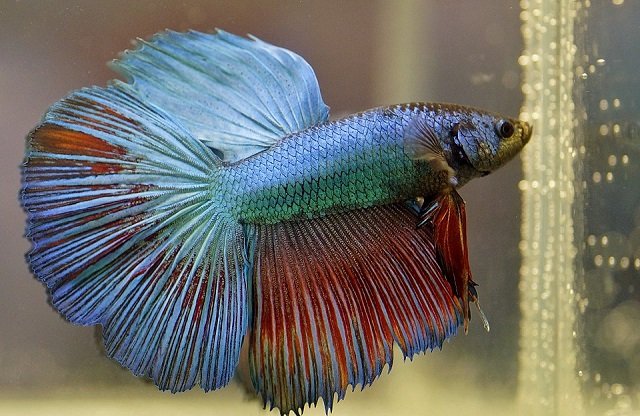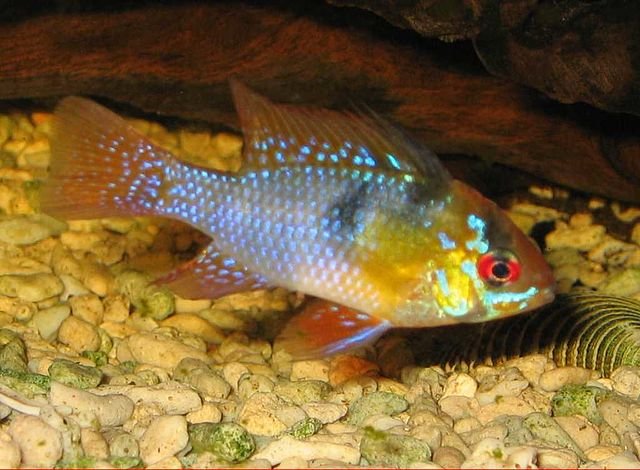Freshwater aquarium shrimp, also known as dwarf shrimp, have become increasingly popular among aquarists due to their stunning colors, ease of care, and ability to maintain a clean ecosystem. These ornamental shrimp bring life and movement to any aquarium while helping control algae and leftover food.
Whether you are a beginner looking for an easy-to-care-for species or an experienced aquarist interested in breeding aquarium shrimp, this guide will cover everything you need to know about freshwater shrimp care, tank setup, shrimp tank ideas, and more. In this article, we have gathered information on the main aquarium shrimp species currently marketed in the ornamental industry.
What are shrimp?
- 1 What are shrimp?
- 2 What do aquarium shrimp eat?
- 3 How to breed aquarium shrimp?
- 4 Care aquarium shrimp
- 5 Types of aquarium shrimp
- 6 Compatibility of aquarium shrimp and fish
- 7 Shrimp and aquarium plants
- 8 Diseases in aquarium shrimp
- 9 Conclusion
- 10 Frequently asked questions and solutions
- 11 References
- 12 Entradas relacionadas:
Shrimp, also known as prawns, are crustaceans (invertebrates) with elongated bodies, and their primary mode of locomotion is swimming.
Shrimp play essential roles in food chains and serve as a food source for fish, mammals, and humans. The shrimp farming industry is a significant sector worldwide.
In this article, we focus exclusively on aquarium shrimp; however, on AquaHoy, you can find abundant information about marine and freshwater shrimp.
Aquarium shrimp
Aquarium shrimp, also known as dwarf shrimp, are becoming increasingly popular among aquarium enthusiasts.
A common question among aquarists is: What are shrimp used for in an aquarium? Beyond the beauty and color that shrimp add to your tank, they can help keep it clean.
The two main genera of dwarf aquarium shrimp are Neocaridina and Caridina. The primary difference between them is that Caridina shrimp species only reproduce with members of their own species, while Neocaridina species can interbreed with different species (Tammy, 2021).
Stay Always Informed
Join our communities to instantly receive the most important news, reports, and analysis from the aquaculture industry.
The Neocaridina genus includes freshwater shrimp species native to China, Japan, Korea, Vietnam, and Taiwan. Many of these species are highly popular in the aquarium trade.
Additionally, Neocaridina shrimp species are easier to care for than Caridina shrimp, making them a great choice for beginners.
Benefits of having shrimp in your aquarium
- Algae control: Shrimp are excellent algae eaters, helping keep the aquarium clean and balanced.
- Substrate cleaning: They feed on leftover food and decomposing organic matter, contributing to a cleaner aquarium bottom.
- Aesthetic appeal: Their colors and movements add a unique visual charm to the tank.
- Interesting behavior: Watching shrimp interact with each other and their environment is fascinating.
- Easy to care for (some species): Many shrimp species are relatively easy to maintain, making them ideal for beginners.
What do aquarium shrimp eat?
Freshwater dwarf shrimp primarily feed on algae; however, they will accept almost any type of food (Aquenon, 2021). A recommended practice is to refrain from feeding aquarium shrimp one day a week to encourage them to forage at the bottom of the tank, which helps with cleaning.
You can provide your shrimp with shrimp pellets, spirulina flakes, and also include inert materials in your aquarium to promote the formation of biofilms, which serve as food for cherry shrimp (Neocaridina heteropoda heteropoda), as recommended by Viau et al., (2016).
For the species Neocaridina davidi, Namaei et al., (2018) suggest incorporating spirulina meal at a level of 8–10% to enhance growth, survival, and reproductive performance.
Commercial shrimp-specific foods
There are foods specifically formulated to meet the nutritional needs of shrimp. These are usually available in the form of sinking pellets or flakes. Look for foods that contain high-quality ingredients such as spirulina, seaweed, and vegetables.
Natural foods
- Algae: Shrimp are excellent algae eaters. If your aquarium lacks sufficient algae, you can supplement with algae wafers or powdered spirulina.
- Biofilm: A thin layer of microorganisms (bacteria, algae, fungi) that grows on aquarium surfaces. This is a natural and essential food source for shrimp.
- Blanched Vegetables: You can offer small amounts of blanched vegetables (briefly boiled to soften them), such as zucchini, spinach, peas (skin removed), carrots, and cucumber. Remove any uneaten vegetables after a few hours to prevent water contamination.
Calcium and mineral supplements
Calcium is essential for shrimp exoskeleton formation. You can provide calcium supplements in the form of shrimp mineral stones or by adding crushed eggshells (previously boiled and cleaned) to the aquarium.
Feeding frequency and proper portions
Feed your shrimp in small amounts once or twice a day. The food should be consumed within 2–3 hours. It is better to underfeed than to overfeed. Overfeeding can lead to water quality issues and the proliferation of planarians (flatworms) and other unwanted organisms.
Feeding ornamental shrimp larvae
Subamia y Himawan (2016) studied the feeding behavior of cherry shrimp larvae under different initial diets and concluded that a combination of Artemia and aquatic plants yielded the highest growth and survival rates.
Hamasaki et al., (2020) evaluated the dietary effects of phytoplankton and zooplankton on the survival, duration, and growth of Caridina multidentata (Amano shrimp) larvae. Their results showed that rotifers significantly improved larval survival and development.
Foods that enhance the color of aquarium shrimp
The most attractive feature of ornamental shrimp is their coloration. To maintain proper pigmentation, ensure a well-balanced diet. To enhance the bright red hue of cherry shrimp, Ikhsan et al, (2012) recommend adding 100 mg/kg of canthaxanthin to their food, while Laohavisuti and Ruangdej (2014) suggest using 200 mg/kg of astaxanthin.
Luna-Vivaldo et al., (2024) discovered a way to enhance the vibrant colors of ornamental shrimp (Neocaridina davidi) using a specialized microalgae-rich diet, achieving the following results:
- Improved coloration: Both red and blue shrimp varieties displayed enhanced color intensity after consuming microalgae.
- Specificity matters:
- Red shrimp (NdR) responded best to Haematococcus pluvialis, which is rich in astaxanthin, achieving a 74.2% color enhancement.
- Blue shrimp (NdB) showed the most significant improvement (56.2%) when fed Spirulina platensis, which is rich in phycocyanins.
- Double the impact: The microalgae diet not only intensified color but also doubled the chromatophore-covered area in red and blue shrimp. In red shrimp fed Haematococcus pluvialis, color intensity even quadrupled!
How to breed aquarium shrimp?
Many aquarium shrimp reproduce easily in captivity; however, success varies from species to species. For example, cherry shrimp and some other Neocaridina species can quickly become large colonies without the help of the aquarist.
Crystal shrimp are a bit more challenging, while Amano shrimp are nearly impossible to breed successfully since they require brackish water for reproduction.
Freshwater dwarf shrimp, depending on the species, reach sexual maturity around 4 to 6 months of age. If both sexes are present in the aquarium, they will start to reproduce naturally.
Once molting is complete, females release pheromones, attracting males that fertilize the eggs. After fertilization, females carry the eggs between their pleopods for about 2 to 3 weeks until they hatch. Each batch contains an average of 20-30 eggs.
Shrimp species of the Caridina genus require brackish water for larval growth. In this regard, Hamasaki et al., (2023)determined that Amano shrimp larvae grow well at salinities ranging from 8.5 to 17 ppm.
Care aquarium shrimp
Aquarium shrimp thrive in clean water with a pH range of 6.5 to 7.5 and a temperature range of 24 to 27°C. However, it is essential to consider the specific water quality requirements of each species.
Experts suggest that larger shrimp species such as ghost shrimp, Amano shrimp, and bamboo shrimp can be kept in 10- to 55-gallon tanks, while cherry shrimp and crystal shrimp are better suited for 10-gallon tanks or smaller.
Additionally, shrimp prefer mature aquariums since they are more stable and tend to have natural food sources available. You should never place dwarf shrimp in a newly set up tank (Aquenon, 2021).
Laohavisuti y Ruangdej (2014) recommend breeding cherry shrimp in tanks with a black or red background to enhance pigmentation. Similarly, Plichta et al., (2021) reported that dwarf shrimp, regardless of coloration, prefer darker backgrounds.
In Table 1, we summarize the key water quality parameters for breeding freshwater aquarium shrimp. Further below, you will find a detailed species-specific description.
Table 1. Water Quality Parameters for Breeding Freshwater Aquarium Shrimp.
| Parameter | Neocaridina | Caridina |
|---|---|---|
| Temperature (°C) | 18 – 29 | 18 – 24 |
| pH | 6.5 – 8.0 | 6.0 – 7.5 |
| Total Dissolved Solids (TDS) (ppm) | 200 – 300 | 100 – 200 |
| General Hardness (GH) (dGH) | 4 – 8 | 4 – 6 |
| KH: Carbonate Hardness / Alkalinity (dKH) | 3 – 15 | 0 – 2 |
Shrimp need hiding places, especially during molting (when they are most vulnerable) and for females carrying eggs.
Cave and shelter options
- Ceramic or resin caves designed for aquariums.
- PVC tubes cut and covered with moss.
- Carefully stacked rock piles.
- Driftwood with cavities.
Additional decoration: rocks, driftwood, and other elements
Rocks and driftwood not only add a natural look to the aquarium but also provide extra surfaces for biofilm and algae growth, which shrimp consume. Ensure that any rock or wood used is aquarium-safe and does not alter water parameters (e.g., some rocks may increase water hardness).
Notably, Carvalho-Batista et al., (2023) evaluated the preference of Neocaridina davidi for four types of shelters (rock, Vesicularia sp., Egeria sp., and wood) and found that shrimp preferred Vesicularia sp. as the most frequently used refuge.
Types of aquarium shrimp
Which shrimp species is ideal for your aquarium? The answer depends on the tank size and composition, as well as the basic water quality requirements (temperature, pH, hardness levels) of each species.
Some shrimp species may be too large or aggressive for a small aquarium, leading to overcrowding. Below is information on different shrimp species available in pet stores:
Cherry red shrimp (Neocaridina heteropoda heteropoda)
The Cherry Red Shrimp is a freshwater species that is easy to care for and displays vibrant colors.
These small shrimp have bright red bodies with black or brown spots along their backs and white-tipped antennae. Additionally, yellow and blue shrimp varieties (Neocaridina blue) are also available.
Cherry Red Shrimp can grow up to 4 cm and are ideal for small aquariums (6 to 10 gallons) with a dark substrate. They thrive in water with a pH of 7.0 to 7.8 and a temperature range of 22 to 28°C. According to Tropea (2015), 28°C is the optimal temperature for their growth and reproduction.
Cherry Red Shrimp have a lifespan of up to one year, depending on aquarium conditions. Feeding these shrimp is simple; they accept commercial fish or shrimp food without any issues.
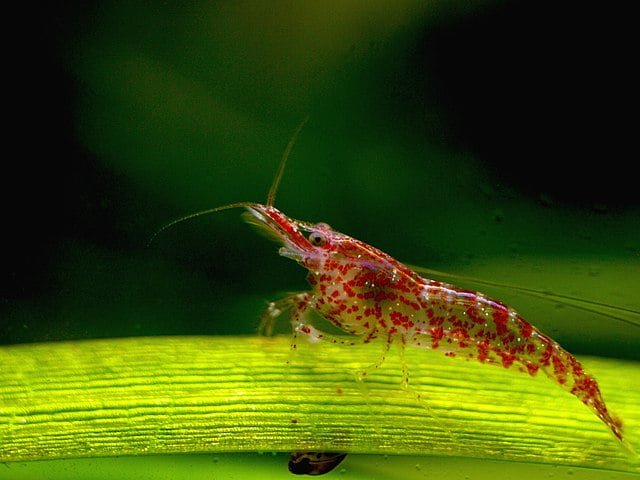
Sean Murray from Edinburgh, Scotland.
Sakura shrimp (Neocaridina davidi)
Sakura shrimp, also known as Cherry Shrimp, are a 4 cm freshwater species available in various colors besides red, including yellow, orange, green, blue, and pink.
Not only are Sakura shrimp beautiful, but they also make excellent members of your aquarium’s clean-up crew, as they scavenge for leftover fish food and consume algae.

Amano shrimp (Caridina multidentata)
Amano shrimp (Caridina multidentata), also known as algae-eating shrimp, are one of the most popular shrimp species in aquariums. They are named after Takashi Amano, the father of aquascaping.
These crustaceans have a beautiful gray and white pattern with long, translucent antennae.
Amano shrimp can grow up to 5 cm and are excellent at keeping aquariums clean, as they feed on various types of algae. They are considered very hardy and can thrive in a range of water conditions.
Amano shrimp prefer water temperatures between 18–27°C, a pH of 6.5–8.0, and a GH above 4° (70 ppm).
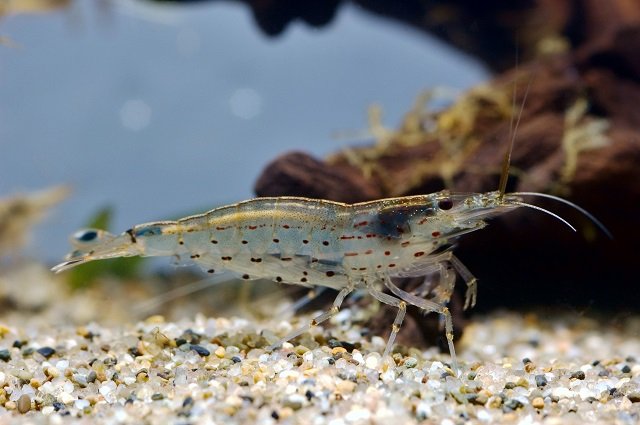
Ghost shrimp (Palaemonetes paludosus)
Ghost shrimp (Palaemonetes paludosus), also known as glass shrimp, are useful inhabitants in aquariums. This group includes several species ranging in size from 4 to 13 cm.
These shrimp have a translucent body with red stripes.
Ghost shrimp are excellent scavengers, feeding on various debris and leftover food in the aquarium substrate. For proper nutrition and growth, their diet should be supplemented with vegetable pieces and boiled spinach leaves.
Glass shrimp can thrive in a variety of water conditions but prefer temperatures between 22–26°C and a pH of 7.0.
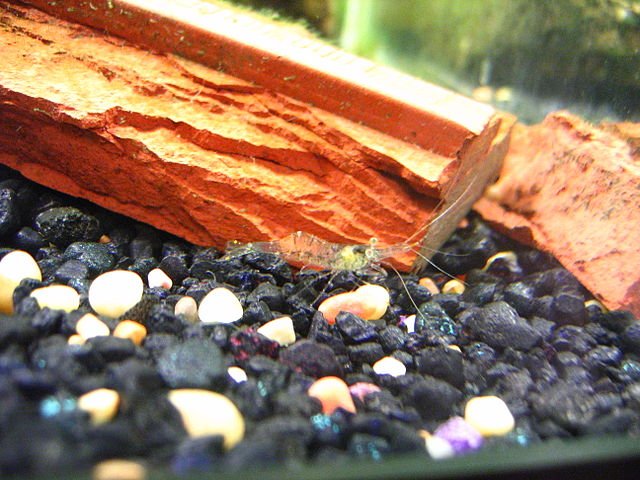
Vampire shrimp (Atya gabonensis)
Vampire shrimp are native to West Africa and South America (Yang, 2022). They have a red coloration with three distinct pairs of white spots on their back and vibrant orange eyes.
The coloration of these crustaceans can vary significantly; they can be found in shades of blue, gray, brown, and pink. These shrimp frequently change color multiple times throughout the year.
Vampire shrimp are ideal for small community aquariums with plenty of hiding spots and can live up to five years.
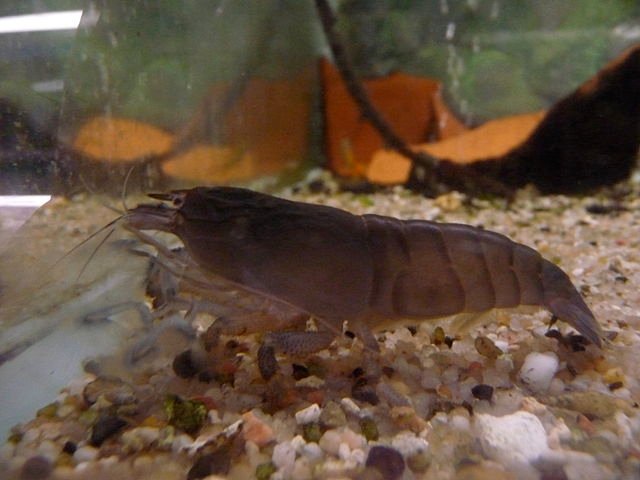
Bamboo shrimp (Atyopsis moluccensis)
The bamboo shrimp (Atyopsis moluccensis) is native to Southeast Asia and can grow up to 9 cm. These shrimp are filter feeders.
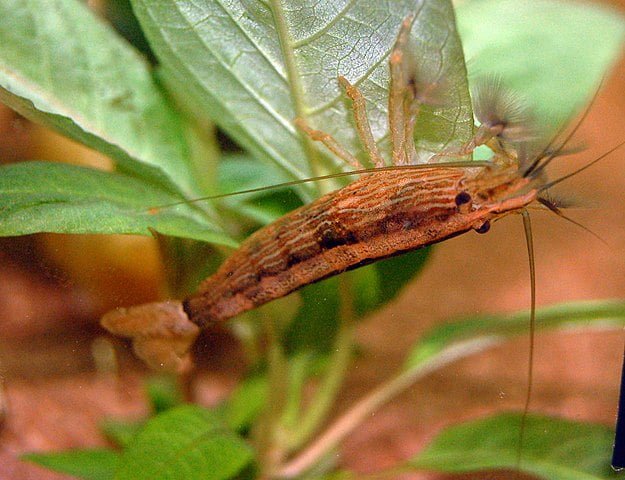
Compatibility of aquarium shrimp and fish
Aquarium shrimp are active creatures, almost always engaged in foraging for algae or other food sources.
Most species of dwarf shrimp are vulnerable to predation by larger fish. In this sense, you can keep your shrimp with fish such as:
Large and aggressive fish are not suitable for keeping with dwarf shrimp. Therefore, species such as barbs, bettas, cichlids, goldfish, and other shrimp-eating fish are not recommended.
Additionally, dwarf shrimp can live with various species of freshwater snails.
Aquenon (2021) recommends avoiding the combination of different shrimp species from the same genus in the same aquarium to prevent crossbreeding. This means that two different Neocaridina species should not be kept together, but a Neocaridina can be combined with a Caridina.
Strategies for successful coexistence
- Provide plenty of hiding spots: Dense plants, Java moss, caves, and other shelters are essential for shrimp to escape from fish.
- Introduce shrimp first: If possible, add the shrimp to the aquarium before introducing fish. This allows them time to settle and find shelter.
- Observe carefully: Monitor interactions between fish and shrimp. If the fish harass the shrimp, you may need to separate them.
- Feed fish properly: A well-fed fish is less likely to hunt shrimp.
Shrimp and aquarium plants
Aquarium shrimp should live in planted tanks with species such as Java moss or Najas, as these improve their well-being.
Plants act as natural filters, helping to maintain low nitrate and ammonia levels in the aquarium (Tammy, 2021). In this regard, Walstad (2023) describes two methods for setting up small planted shrimp tanks: the Bowl Setup Method, which is quick and easy, and the Dry Start Method (DSM).
Additionally, aquatic plants provide more surface area for biofilm and microalgae to grow, offering more grazing areas for shrimp. Dead plant matter also serves as food for shrimp.
Vazquez et al., (2022) studied the effect of aquatic plants Vesicularia sp., Ceratophyllum sp., and Cabomba sp., as well as a green plastic mesh, and concluded that Vesicularia sp. could improve the survival of cherry shrimp (Neocaridina davidi).
Recommended aquarium plants for shrimp
- Java Moss (Taxiphyllum barbieri): Essential in any shrimp tank, providing excellent shelter and biofilm growth surface.
- Anubias (various species): Hardy, slow-growing plants that require little light.
- Java Fern (Microsorum pteropus): Easy to care for, attaches to rocks and driftwood.
- Bucephalandra (various species): Epiphytic plants with a wide range of colors and shapes.
- Floating plants (duckweed, Salvinia, etc.): Help control nitrates and provide shade.
Diseases in aquarium shrimp
Parasites
Maciaszek et al., (2018) described six epibionts found on Neocaridina davidi shrimp from Taiwan. Some exhibit a parasitic lifestyle (Cladogonium ogishimae, Saprolegnia sp., Scutariella japonica), while others (phyla Ciliophora and Rotifera) may indicate organic matter levels in the water.
Bauer et al., (2021) documented parasitism of the green alga Cladogonium sp. on the pleopods of dwarf shrimp Neocaridina davidi. The alga compromised the shrimp’s body surface, with its rhizoids penetrating the chitin layer and reaching the subcutaneous tissue.
Schneider et al., (2022) reported the first occurrence of microsporidian parasites in ornamental shrimp Neocaridina davidi collected from a stream in Germany. They identified the microsporidian parasite Enterocytozoon hepatopenaei.
Conclusion
Aquarium shrimp are an excellent choice for hobbyists. Besides adding beauty and color, they contribute to aquarium cleanliness by consuming dead plants and uneaten fish food.
There is a wide variety of aquarium shrimp, and the choice depends on the type of tank and fish being kept.
Frequently asked questions and solutions
Why are my shrimp hiding?
- Stress: Shrimp hide when they feel stressed, such as after being introduced into a new tank, after a water change, or if harassed by fish.
- Molting: Shrimp hide when molting their exoskeleton, as they are vulnerable during this time.
- Egg-carrying females: Females carrying eggs often seek shelter to protect their offspring.
- Lack of hiding spots: If there are not enough hiding places, shrimp may be less visible.
How many shrimp can I keep per liter?
A general rule is 2–5 Neocaridina shrimp per liter. However, it is best to start with fewer and allow the population to grow gradually.
Are my shrimp molting or dead?
- A molted shrimp shell is translucent and looks like an empty shrimp.
- A dead shrimp will have an opaque color (often pink or orange) and will not be hollow.
Other common questions:
Why aren’t my shrimp breeding?
Ensure you have both males and females, maintain proper water parameters, and provide a nutritious diet.
What should I do if I find planaria in my tank?
Planaria are flatworms that may prey on baby shrimp. Reduce feeding and use planaria traps.
Can I use tap water for my shrimp tank?
No, tap water contains chlorine and chloramine, which are toxic to shrimp. Use a water conditioner to neutralize these chemicals.
References
Aquenon. 2021. Freshwater Shrimp
Aquarium Co-op. Top 5 Dwarf Shrimp for Your Next Freshwater Aquarium.
Bauer J, Jung-Schroers V, Teitge F, Adamek M, Steinhagen D (2021) Association of the alga Cladogonium sp. with a multifactorial disease outbreak in dwarf shrimp (Neocaridina davidi). Dis Aquat Org 146:107-115. https://doi.org/10.3354/dao03625
Carvalho-Batista, A., Nogueira, C. S., Costa, R. C., & Pantaleão, J. A. F. (2023). Shelter preference and variation in the daily activity pattern of the ornamental shrimp Neocaridina davidi (Caridea: Atyidae). Nauplius, 31, e2023018.
Ikhsan Amin Mohamad, Rosidah -, Walim Lili, Sukarman -, Agus Priyadi. 2012. PENINGKATAN KECERAHAN WARNA UDANG RED CHERRY (Neocaridina heteropoda) JANTAN MELALUI PEMBERIAN ASTAXANTHIN DAN CANTHAXANTHIN DALAM PAKAN. Jurnal Perikanan dan Kelautan, Vol 3, No 4.
Hamasaki Katsuyuki, Sota Nishimoto, Masakazu Okada, Asahi Kimura, Kosei Otsubo, Shigeki Dan. 2020. Dietary effects of phytoplankton and zooplankton on larval survival, duration and growth of four Caridina species (Decapoda: Caridea: Atyidae) under laboratory conditions. Crustacean Research. https://doi.org/10.18353/crustacea.49.0_225
Hamasaki, K., Kawakami, Y., Kondo, S. et al. Survival and development strategy of starved early-stage-zoeae of five amphidromous shrimp species in the genus Caridina under different salinity and temperature conditions. Hydrobiologia 850, 137–150 (2023). https://doi.org/10.1007/s10750-022-05050-0
Laohavisuti, N., & Ruangdej, U. (2014). Effect of Dietary Astaxanthin and Background Color on Pigmentation and Growth of Red Cherry Shrimp, Neocaridina heteropoda. Journal of Fisheries and Environment, 38(1), 1–7. Retrieved from https://li01.tci-thaijo.org/index.php/JFE/article/view/80595
Luna-Vivaldo, Irán, Pérez-Legaspi, Ignacio Alejandro, Jiménez-García, María Isabel, Ortega-Clemente, Luis Alfredo, & Platas Pinos, Ana Leticia. (2024). The coloration of Neocaridina davidi (Bouvier, 1904) (Caridea, Atydae) fed with live microalgae Haematococcus pluvialis and the cyanobacteria Spirulina (Arthrospira) platensis. Latin american journal of aquatic research, 52(2), 298-306. https://dx.doi.org/10.3856/vol52-issue2-fulltext-3000
Maciaszek, R., Kamaszewski, M., Struzynski, W., & Lapa, P. (2018). Epibionts of ornamental freshwater shrimps bred in Taiwan. Annals of Warsaw University of Life Sciences-SGGW. Animal Science, 57.
Namaei Kohal, M., Esmaeili Fereidouni, A., Firouzbakhsh, F. et al. Effects of dietary incorporation of Arthrospira (Spirulina) platensis meal on growth, survival, body composition, and reproductive performance of red cherry shrimp Neocaridina davidi (Crustacea, Atyidae) over successive spawnings. J Appl Phycol 30, 431–443 (2018). https://doi.org/10.1007/s10811-017-1220-5
Plichta, Zuzanna, Jarosław Kobak, Rafał Maciaszek, and Tomasz Kakareko. 2021. “All Shades of Shrimp: Preferences of Colour Morphs of a Freshwater Shrimp Neocaridina davidi (Decapoda, Atyidae) for Substrata of Different Colouration” Animals 11, no. 4: 1071. https://doi.org/10.3390/ani11041071
Schneider R, Prati S, Grabner D, Sures B (2022) First report of microsporidians in the non-native shrimp Neocaridina davidi from a temperate European stream. Dis Aquat Org 150:125-130. https://doi.org/10.3354/dao03681
Subamia, I Wayan; Himawan, Yogi. 2016. Performance Of Red Cherry Shrimp Larvae (Neocaridina Heteropoda) With Different Initial Feed. Universitas Riau.
Tammy. 2021. A Guide for Keeping Freshwater Shrimp. Buce Plant
Tropea C, Stumpf L, López Greco LS (2015) Effect of Temperature on Biochemical Composition, Growth and Reproduction of the Ornamental Red Cherry Shrimp Neocaridina heteropoda heteropoda (Decapoda, Caridea). PLoS ONE 10(3): e0119468. https://doi.org/10.1371/journal.pone.0119468
Vazquez, N. D., Sganga, D. E., & López Greco, L. S. (2022). Effect of different substrates on growth and biochemical composition of the ornamental “red cherry” caridean shrimp, Neocaridina davidi (Atyidae). Aquaculture Research, 53, 3001– 3009. https://doi.org/10.1111/are.15812
Viau, V.E., Marciano, A., Iriel, A. and López Greco, L.S. (2016), Assessment of a biofilm-based culture system within zero water exchange on water quality and on survival and growth of the freshwater shrimp Neocaridina heteropoda heteropoda. Aquac Res, 47: 2528-2542. https://doi.org/10.1111/are.12701
Walstad, D. 2023. Small Planted Tanks for Pet Shrimp.
Yang Alison. 2022. 17 Types Of Freshwater Aquarium Shrimp You Need To See. Aquarium Source
Editor at the digital magazine AquaHoy. He holds a degree in Aquaculture Biology from the National University of Santa (UNS) and a Master’s degree in Science and Innovation Management from the Polytechnic University of Valencia, with postgraduate diplomas in Business Innovation and Innovation Management. He possesses extensive experience in the aquaculture and fisheries sector, having led the Fisheries Innovation Unit of the National Program for Innovation in Fisheries and Aquaculture (PNIPA). He has served as a senior consultant in technology watch, an innovation project formulator and advisor, and a lecturer at UNS. He is a member of the Peruvian College of Biologists and was recognized by the World Aquaculture Society (WAS) in 2016 for his contribution to aquaculture.
